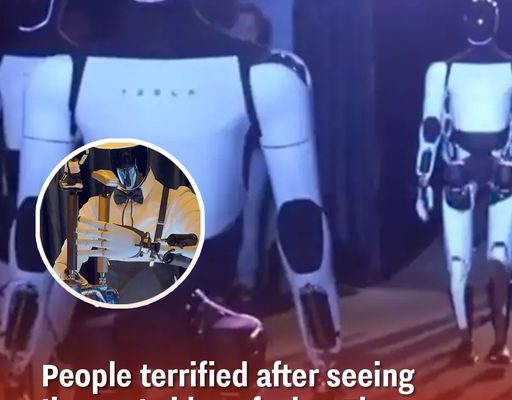Elon Musk, CEO of Tesla, has unveiled the latest groundbreaking product from the electric vehicle and clean energy company: the **Tesla Optimus**, a humanoid helper robot designed to perform a variety of tasks, both in industrial and household settings. The unveiling took place during Tesla’s annual AI Day event, and the Optimus robot was met with a mixture of awe, excitement, and intrigue. The event demonstrated Tesla’s bold ambition to expand beyond electric cars and into the realm of robotics, with Musk positioning the robot as a solution to the global labor shortage and a new frontier for AI.
The Optimus robot, also referred to as Tesla Bot, is designed to handle mundane, repetitive, and even dangerous tasks that humans currently perform. Musk’s vision is for the robot to be both practical and safe, with an emphasis on augmenting human productivity rather than replacing human workers entirely. He assured the audience that Tesla has built safety mechanisms into Optimus to ensure that it is “friendly” and poses no threat to humans—an important point, given widespread concerns about the potential dangers of autonomous robots.
### The Reveal of Tesla Optimus
Standing about 5 feet 8 inches tall, weighing around 125 pounds, and powered by artificial intelligence similar to that used in Tesla’s self-driving cars, Optimus is designed to navigate the human world. The robot has a sleek, minimalistic appearance, bearing the characteristic Tesla design ethos of simplicity and elegance. Its face is a black screen that can display information, while its body is composed of lightweight materials that make it agile yet strong enough to handle various tasks.
The robot is equipped with 40 electromechanical actuators that allow it to move its arms, legs, and head with surprising fluidity. Tesla engineers explained that Optimus is capable of lifting objects weighing up to 150 pounds, carrying loads of up to 45 pounds, and walking at a pace of about 5 miles per hour. These capabilities were demonstrated during the event as Optimus was shown performing basic tasks like lifting boxes, watering plants, and assembling small items in a factory setting.
Optimus uses Tesla’s Full Self-Driving (FSD) AI software to navigate environments autonomously. This AI has been fine-tuned over the years through Tesla’s fleet of electric vehicles, which constantly collect data from the roads they drive on. The robot’s ability to perceive and interact with the world, Musk noted, is a direct result of Tesla’s experience in building AI systems for self-driving cars.
While the initial demonstration was relatively simple, Tesla’s engineers pointed out that the robot’s software and capabilities would continue to improve over time, especially with the integration of advanced machine learning algorithms that allow Optimus to learn from its environment. Musk emphasized that Optimus would not just be capable of performing repetitive tasks, but also of making decisions and responding to new situations with a high degree of autonomy.
### The Purpose Behind Optimus
Elon Musk’s long-term vision for Tesla has always been ambitious, extending far beyond electric cars. With the unveiling of Optimus, Musk reiterated his belief that Tesla is not merely a car company, but an AI and robotics company at its core. He described Optimus as part of Tesla’s broader mission to “accelerate the world’s transition to sustainable energy,” but also as a way to revolutionize labor and manufacturing processes.
“Optimus is designed to be a general-purpose robot,” Musk said during the event. “It’s not limited to any specific task. It can handle physical work that humans typically do, whether that’s in factories, homes, or other industries. The goal is to make it affordable and widely accessible.”
Musk noted that many industries suffer from labor shortages, particularly in low-skill, repetitive jobs that humans often find monotonous or dangerous. Optimus, he argued, could alleviate these shortages by taking on tasks like factory line assembly, warehouse logistics, and even domestic chores, freeing humans to focus on more creative, strategic, or fulfilling work.
One of the most intriguing aspects of Optimus is its potential use in households. Musk envisions a future where people can own a humanoid robot that handles a wide range of household chores—cleaning, cooking, grocery shopping, or even providing companionship to the elderly. This idea drew significant attention from the public, as the prospect of a household robot that can integrate into daily life has long been a staple of science fiction. Musk, however, was adamant that such a future is not far off, and that Tesla’s advancements in AI and robotics will bring it closer to reality within the next few years.
### Safety Concerns and AI Ethics
One of the most pressing concerns surrounding the introduction of robots like Optimus is the potential risk they pose if not properly controlled. Autonomous robots that can move freely in human environments inevitably raise questions about safety, privacy, and ethics. Musk directly addressed these concerns, emphasizing that Tesla is taking steps to ensure Optimus is safe to interact with humans and will not become a threat.
“Tesla’s AI is designed with safety at the core,” Musk explained. “We’re making sure that Optimus can be shut down easily, that it doesn’t have any dangerous features, and that it’s always working in a way that’s safe for humans.” He added that the robot’s software is being designed with multiple fail-safes and redundant systems to prevent malfunctioning or unintended actions.
Musk also touched on the broader issue of AI ethics, a subject that has become increasingly important as AI technology continues to evolve. He acknowledged that while Tesla’s AI team is working on building ethical guidelines into the robot’s decision-making process, there are still philosophical and societal questions that need to be addressed as robots like Optimus become more integrated into everyday life.
“We’re entering a new era with AI and robotics,” Musk said. “We need to think carefully about how we use this technology, how we ensure it benefits humanity, and how we avoid unintended consequences.”
### The Potential Impact of Optimus on the Workforce
The introduction of Optimus has sparked significant debate about the future of work and the role of robots in human society. While Musk highlighted the potential for Optimus to alleviate labor shortages and increase productivity, there are concerns about the displacement of human workers, particularly in industries that rely on manual labor. The prospect of robots replacing workers in fields like manufacturing, logistics, and agriculture has already raised alarms among economists and labor advocates.
Musk, however, remains optimistic that Optimus will create more opportunities than it eliminates. “The goal is not to replace human workers, but to help them,” he said. “Optimus can take over the repetitive and dangerous tasks that humans don’t want to do, allowing people to focus on more creative and meaningful work. This isn’t about job loss—it’s about job transformation.”
Musk’s comments reflect his broader vision of a future where AI and robotics are integrated into society in ways that improve human lives rather than detract from them. He has long advocated for the use of technology to solve societal problems, and with Optimus, he sees the potential to address both labor shortages and improve quality of life by taking over menial tasks.
### The Road Ahead for Tesla Optimus
Although the Optimus robot is still in its early stages, Musk is confident that it will eventually become a major part of Tesla’s business. He described a future where millions of Optimus robots could be deployed in factories, homes, and various industries worldwide. While he did not provide a specific timeline for when Optimus will be widely available, Musk hinted that a consumer version of the robot could be released within the next five to ten years, at a cost “less than a car.”
The unveiling of Optimus marks another bold step in Tesla’s evolution, as the company continues to push the boundaries of AI and robotics. While there are still significant challenges to overcome, both technically and ethically, Tesla’s Optimus has the potential to revolutionize industries, change the future of work, and transform how humans live and interact with technology. As Musk and his team continue to develop the robot’s capabilities, the world will be watching closely to see how Tesla’s latest innovation reshapes the landscape of AI and robotics in the years to come.



